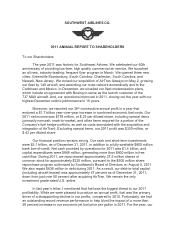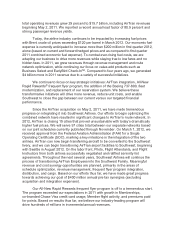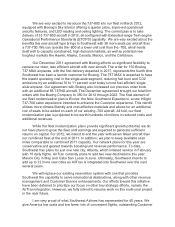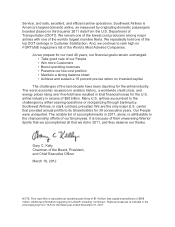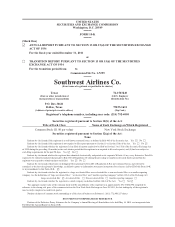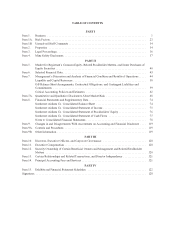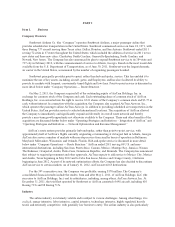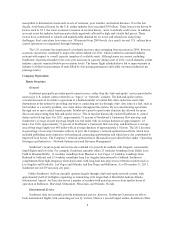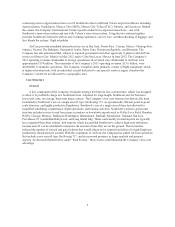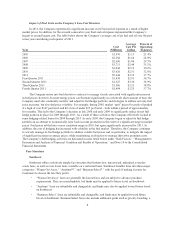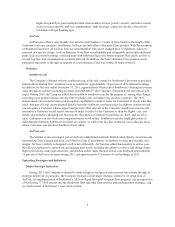Southwest Airlines 2011 Annual Report Download - page 7
Download and view the complete annual report
Please find page 7 of the 2011 Southwest Airlines annual report below. You can navigate through the pages in the report by either clicking on the pages listed below, or by using the keyword search tool below to find specific information within the annual report.PART I
Item 1. Business
Company Overview
Southwest Airlines Co. (the “Company”) operates Southwest Airlines, a major passenger airline that
provides scheduled air transportation in the United States. Southwest commenced service on June 18, 1971, with
three Boeing 737 aircraft serving three Texas cities: Dallas, Houston, and San Antonio. Southwest ended 2011
serving 72 cities in 37 states throughout the United States, which included the addition of service in 2011 to two
new states and three new cities: Charleston, South Carolina; Greenville-Spartanburg, South Carolina; and
Newark, New Jersey. The Company has also announced its plan to expand Southwest service to its 38th state and
73rd city in February 2012, with the commencement of service to Atlanta, Georgia. Based on the most recent data
available from the U.S. Department of Transportation, as of June 30, 2011, Southwest was the largest domestic
air carrier in the United States, as measured by the number of originating passengers boarded.
Southwest principally provides point-to-point, rather than hub-and-spoke, service. This has enabled it to
maximize the use of key assets, including aircraft, gates, and Employees, and has also facilitated its ability to
provide its markets with frequent, conveniently timed flights and low fares. Point-to-point service is discussed in
more detail below under “Company Operations — Route Structure.”
On May 2, 2011, the Company acquired all of the outstanding equity of AirTran Holdings, Inc. in
exchange for common stock of the Company and cash. Each outstanding share of common stock of AirTran
Holdings, Inc. was converted into the right to receive 0.321 shares of the Company’s common stock and $3.75 in
cash, without interest. In connection with the acquisition, the Company also acquired AirTran Airways, Inc.,
which operates the passenger airline AirTran Airways. In addition to providing scheduled air transportation in the
United States, AirTran provides service to selected international locations. The acquisition of AirTran allowed
the Company to immediately and significantly expand and diversify its overall route network and thereby
provide a near-term growth opportunity not otherwise available to the Company. These and other benefits of the
acquisition are discussed further below under “Operating Strategies and Initiatives – Integration of AirTran” and
“Operating Strategies and Initiatives — Network Optimization and Revenue Management.”
AirTran’s route system provides primarily hub-and-spoke, rather than point-to-point, service, with
approximately half of AirTran’s flights currently originating or terminating at its largest hub in Atlanta, Georgia.
AirTran also serves a number of markets with non-stop service from smaller bases of operation in Baltimore,
Maryland; Milwaukee, Wisconsin; and Orlando, Florida. Hub-and-spoke service is discussed in more detail
below under “Company Operations — Route Structure.” AirTran ended 2011 serving 68 U.S. and near-
international destinations, including San Juan, Puerto Rico; Cancun, Mexico; Montego Bay, Jamaica; Nassau,
The Bahamas; Oranjestad, Aruba; Punta Cana, Dominican Republic; and Bermuda. The Company has announced
that, subject to required government and other approvals, AirTran expects to add service to Mexico City, Mexico
and Austin, Texas beginning in May 2012 and to Cabo San Lucas, Mexico and Orange County, California
beginning in June 2012. As part of its network optimization efforts, the Company has also decided to discontinue
AirTran service to certain markets. As of January 31, 2012, AirTran served 65 destinations.
For the 39th consecutive year, the Company was profitable, earning $178 million. The Company’s
consolidated financial results include the results, from and after May 2, 2011, of AirTran Holdings, LLC (the
successor to AirTran Holdings, Inc.) and its subsidiaries, including, among others, AirTran Airways, Inc. At
December 31, 2011, the total fleet operated by Southwest or AirTran consisted of 698 aircraft, including 610
Boeing 737s and 88 Boeing 717s.
Industry
The airline industry is extremely volatile and is subject to various challenges. Among other things, it is
cyclical, energy intensive, labor intensive, capital intensive, technology intensive, highly regulated, heavily
taxed, and extremely competitive, with generally low barriers to entry. The airline industry is also particularly

